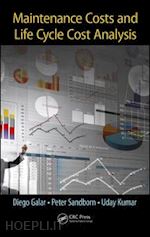Diego Galar has a Msc in Telecommunications and a PhD degree in Manufacturing from the University of Saragossa. He has become Professor in several universities, including the University of Saragossa or the European University of Madrid. He also was a senior researcher in I3A, Institute for engineering research in Aragon, director of academic innovation and subsequently pro-vicechancellor of the university. In industry, he has been technological director and CBM manager. He has authored more than hundred journal and conference papers, books and technical reports in the field of maintenance. Currently, he is Professor of Condition Monitoring in the Division of Operation and Maintenance in LTU, Luleå University of Technology, where he is coordinating several EU-FP7 projects related to different maintenance aspects and is also involved in the SKF UTC centre located in Lulea focused in SMART bearings. He is also visiting Professor in the University of Valencia, Polytechnic of Braganza (Portugal), Valley University (Mexico), Sunderland University (UK) and NIU (USA). Peter Sandborn is a Professor in the CALCE Electronic Products and Systems Center at the University of Maryland. Dr. Sandborn’s group develops obsolescence forecasting algorithms, performs strategic design refresh planning, and lifetime buy quantity optimization. Dr. Sandborn is the developer of the MOCA refresh planning tool. MOCA has been used by private and government organizations worldwide to perform optimized refresh planning for systems subject to technology obsolescence. Dr. Sandborn also performs research in several other life cycle cost modeling areas including maintenance planning and return on investment analysis for the application of prognostics and health management (PHM) to systems, total cost of ownership of electronic parts, transition from tin-lead to lead-free electronics, and general technology tradeoff analysis for electronic systems. Dr. Sandborn is an Associate Editor of the IEEE Transactions on Electronics Packaging Manufacturing and a member of the editorial board of theInternational Journal of Performability Engineering. He is a past conference chair and program chair of the ASME Design for Manufacturing and Life Cycle Conference. He is the author of over 150 technical publications and several books on electronic packaging and electronic systems cost analysis and was the winner of the 2004 SOLE Proceedings and 2006 Eugene L. Grant awards. He has a B.S. degree in engineering physics from the University of Colorado, Boulder, in 1982, and the M.S. degree in electrical science and Ph.D. degree in electrical engineering, both from the University of Michigan, Ann Arbor, in 1983 and 1987, respectively. Uday Kumar, the Chaired Professor of Operation and Maintenance Engineering is Director of Luleå Railway Research Center and Scientific Director of the Strategic Area of Research and Innovation- Sustainable Transport at Luleå University of Technology, Luleå, Sweden. Before joining Luleå University of Technology, Dr. Kumar was Professor of Offshore Technology (Operation and Maintenance Engineering) at Stavanger University, Norway. Professor Kumar has research interest in the subject area of Reliability and Maintainability Engineering, Maintenance modelling, Condition Monitoring, LCC & Risk analysis etc. He has published more than 300 papers in International Journals and peer reviewed Conferences and has made contributions to many edited books. He has supervised more than 25 PhD Theses related to the area of reliability and maintenance. Prof Kumar has been a keynote and invited speaker at numerous congresses, conferences, seminars, industrial forums, workshops and academic Institutions. He is an elected member of the Swedish Royal Academy of Engineering Sciences.











